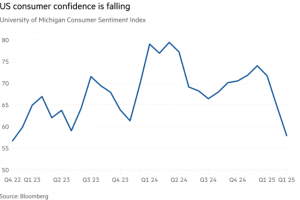Klarna is the Newest IPO Casualty
Thaddius Gamueda
Staff Writer
As consumers are preparing for a volatile outlook after Donald Trump’s reciprocal 10% tariffs on the world and higher rates on certain countries, investors are scrambling for new investments to protect them. The S&P 500 has lost $2.4 trillion according to Reuters and is expected to lose more once reciprocal tariffs are enacted by other countries. This has led to one of the most anticipated IPO’s this month being slashed – Klarna.
What is Klarna?
Klarna is a Swedish fintech giant that has made a name for itself through their buy-now, pay-later services (BNPL). Instead of consumers being bogged down by high interest rates on credit cards, Klarna offers a convenient way to manage cash flow for their customers. They offer multiple plans of 4 2-week payments, 30-day pay in advance, and long-term payment plans ranging from 6-24 months. They have been leveraging cutting-edge technology like AI-driven credit underwriting and automated customer service to streamline operations and reduce costs. Klarna is widely accepted at online shops and brands. As for their halted IPO, Klarna is valued at around $15 billion and hoped to raise $1 billion in capital.
Klarna’s Previous Catalysts for Their IPO
Before the recent headlines of halting, Klarna had great catalysts before their IPO. The BNPL industry is set to reach $160 billion by 2032 according to Reuters. This trend is driven by consumer trends and the growth of e-commerce. Consumer habits are shifting, which is leading to the growth of this industry. Klarna hosts over 90 million consumers, and this number will only rise in the future. As of November 2024, the U.S. accounted for 29% of their profits and they are rapidly expanding into the U.S. Before the IPO, Klarna grew their revenue by 24% in 2024 (up to $2.8 billion) and made a profit of $21 million compared to losses in past years. Klarna’s recent serious win over its rival Affirm in the strategic deal with Walmart futher solidified its position in the BNLP market.
Micro and Macro Fears Over Klarna’s Growth
Klarna’s valuation is nowhere near its original highs of $45-46 billion in 2021. When the venture capital bubble burst in 2021, their valuation plummeted by 85% to $6.7 billion. Klarna has definitely recovered, but there is a serious doubt that the company can ever reach those original levels from 2021. Aside from the valuation drop, Donald Trump’s “liberation day” tariffs have created high volatility in the markets and have led to many investors to panic. Currently, there are many fears of inflation and recession. This is driving the volatility and makes it harder for investors to forecast how Klarna’s stock will act. According to the Financial Times, they state that consumers’ confidence in the economy has dropped over 10% in the first quarter of 2025. Consumer spending in turn will also take a hit because of the recent macro events. Klarna depends on discretionary spending by consumers. When inflation and prices rise, consumer spending goes down. This leads to Klarna’s profits dropping and growth being hindered.

What Now for Klarna and Investors?
Despite the dramatic halt of Klarna’s IPO amid escalating U.S. tariffs and heightened market volatility, the company’s fundamentals remain a mixed bag of cautious optimism and considerable risk. Klarna’s strategic partnerships, along with a recent return to profitability and growth in key markets, continue to underpin its long-term potential. However, broader macroeconomic challenges persist and hold precedence. These recent events go to show how unstable markets can be. This IPO has been in the public eye for almost half a year and has been worked on behind the scenes much longer. Klarna will have to consider the new financial landscape that they and everyone else will find themselves in. These times are troubling for corporations and investors alike.
For investors, Klarna represents a warning sign. The company’s strong operational improvements and innovative strategic moves are promising, yet the overlay of tariff-induced volatility, regulatory headwinds, and competitive pressures have taken center stage. The S&P 500 has seen dramatic selloffs that rival the 2020 covid scene. Many investors are seeing the fallout of Trump’s tariffs and are scrambling to find safety. A word of advice is to stay safe out there in these confusing times. Never rush into a decision without doing your due diligence and stay up to date on news about these ever-changing markets.
Contact Thaddius at Thaddius.Gamueda@shu.edu

